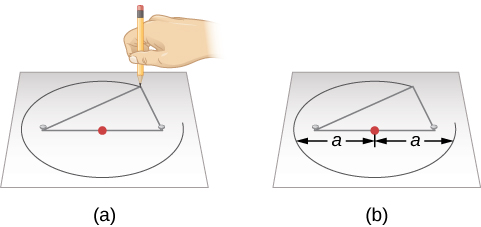| << Chapter < Page | Chapter >> Page > |
Through his analysis of the motions of the planets, Kepler developed a series of principles, now known as Kepler’s three laws, which described the behavior of planets based on their paths through space. The first two laws of planetary motion were published in 1609 in The New Astronomy . Their discovery was a profound step in the development of modern science.
The path of an object through space is called its orbit . Kepler initially assumed that the orbits of planets were circles, but doing so did not allow him to find orbits that were consistent with Brahe’s observations. Working with the data for Mars, he eventually discovered that the orbit of that planet had the shape of a somewhat flattened circle, or ellipse . Next to the circle, the ellipse is the simplest kind of closed curve, belonging to a family of curves known as conic sections ( [link] ).

You might recall from math classes that in a circle, the center is a special point. The distance from the center to anywhere on the circle is exactly the same. In an ellipse, the sum of the distance from two special points inside the ellipse to any point on the ellipse is always the same. These two points inside the ellipse are called its foci (singular: focus ), a word invented for this purpose by Kepler.
This property suggests a simple way to draw an ellipse ( [link] ). We wrap the ends of a loop of string around two tacks pushed through a sheet of paper into a drawing board, so that the string is slack. If we push a pencil against the string, making the string taut, and then slide the pencil against the string all around the tacks, the curve that results is an ellipse. At any point where the pencil may be, the sum of the distances from the pencil to the two tacks is a constant length—the length of the string. The tacks are at the two foci of the ellipse.
The widest diameter of the ellipse is called its major axis . Half this distance—that is, the distance from the center of the ellipse to one end—is the semimajor axis , which is usually used to specify the size of the ellipse. For example, the semimajor axis of the orbit of Mars, which is also the planet’s average distance from the Sun, is 228 million kilometers.

The shape (roundness) of an ellipse depends on how close together the two foci are, compared with the major axis. The ratio of the distance between the foci to the length of the major axis is called the eccentricity of the ellipse.

Notification Switch
Would you like to follow the 'Astronomy' conversation and receive update notifications?